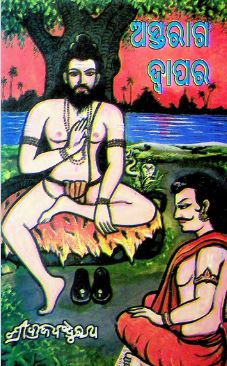The year 2001 marked a significant milestone in Odia literature with the publication of the poetry book “Astarag Dwapar” by the eminent poet Brajabandhu Rath. With this masterpiece, Rath transports his readers into the mystique of Indian mythology, weaving a rich tapestry of verses that evoke the grandeur, tragedy, and spiritual essence of the Dwapar Yuga—the third age in the cosmic cycle of Hindu mythology.
At its core, “Astarag Dwapar” is a remarkable collection that delves deep into mythological themes, touching upon the lives of legendary figures and the events that shaped the epoch. The use of the term ‘Astarag’ in the title reverberates with symbolism, suggesting twilight or the setting sun, an apt metaphor for the concluding era of Dwapar Yuga, enriching the reader’s journey with a sense of impending change and transformation.
Among the multitude of narratives and characters that Rath eloquently brings to life, King Parikshit, the grandson of Arjuna and the ruler of Hastinapura, holds a prominent place. Parikshit’s story unfolds with a poetic finesse, encapsulating both his nobility and his tragic destiny.
In “Astarag Dwapar”, Rath beautifully navigates through the episodes surrounding Parikshit, emphasizing the curse placed upon him that heralded the advent of Kali Yuga, the age of darkness and moral decline. The poet’s engrossing verses highlight Parikshit’s valiant but ultimately futile attempts to ward off the curse. Rath portrays Parikshit as a symbol of the struggle between human frailty and divine will, giving the narrative a potent philosophical undertone.
Rath’s mastery of poetic forms and his evocative language breathe new life into these age-old stories, presenting them in a way that is accessible yet profoundly moving for contemporary readers. His portrayal of Parikshit is not just about the king’s doomed fate but also a reflection on themes of righteousness, duty, and the relentless march of time. The emotional landscape of Parikshit’s tale is vividly painted in Rath’s compelling verses, inviting readers to reassess their understanding of heroism and destiny.
The resonance of Rath’s poetry lies in its ability to blend the mythological grandeur with human emotions, making “Astarag Dwapar” an introspective and immersive reading experience. His use of imagery, metaphors, and rhythmic cadences are meticulously structured, drawing readers into a poetic trance where the boundaries between the ancient and the contemporary blur.
Moreover, Rath’s poignant reflections on the cyclical nature of time and the inevitable decay that follows periods of greatness serve as a subtle commentary on contemporary issues, mirroring the ills of the modern world through the prism of ancient tales. The concept of Dwapar Yuga transitioning into Kali Yuga, with Parikshit’s narrative as a vital axis, offers a framework for understanding the perpetual struggle between good and evil, a theme that continues to resonate deeply in today’s tumultuous times.
In conclusion, Brajabandhu Rath’s “Astarag Dwapar” stands out as a significant contribution to Odia literature, providing readers with a rich, multi-layered exploration of mythological themes through the lens of evocative poetry. The book’s engagement with mythology, particularly the poignant story of Parikshit, not only celebrates the cultural heritage of India but also invites readers to reflect on timeless human themes, making “Astarag Dwapar” a truly invaluable literary treasure.
Books Info
| Books name | Astarag Dwapar/ଅସ୍ତରାଗର ଦ୍ବାପର |
| Editor | Brajabandhu Rath |
| No Of pages | 99 |
| Publisher | Sri Padeepa Kumar Hota |
| Publication | 2001 |
| Printed At | Magnem Printers |
| Distributor | NA |

